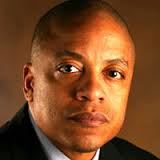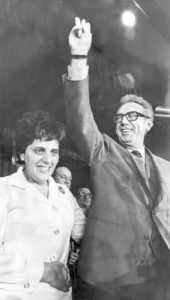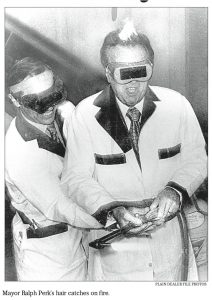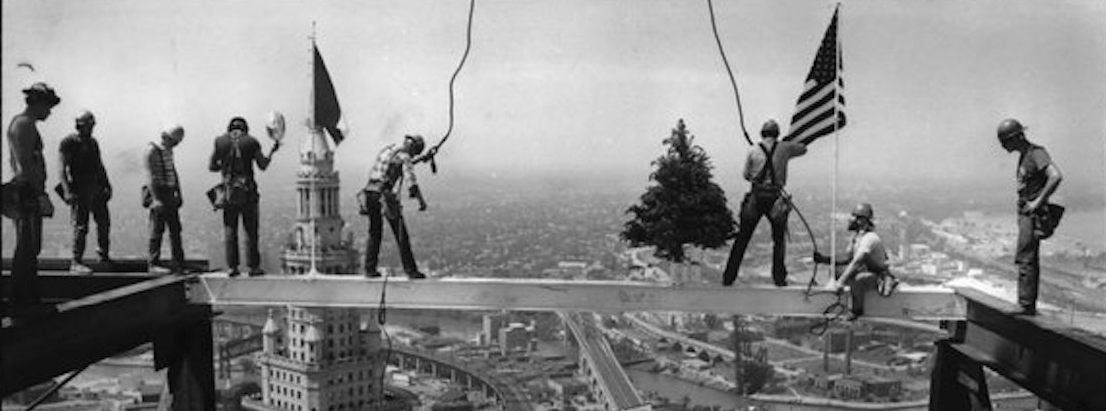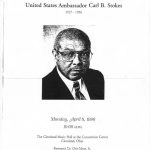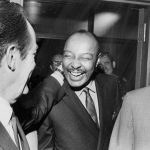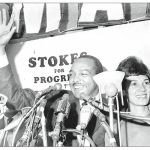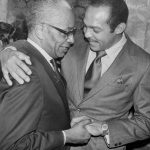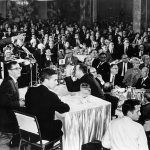As the Gulfstream jet lifted off the runway on its secret mission, Cleveland Stadium came briefly into view.
Scattered among the plane’s leather-upholstered seats were four men who knew the stadium better than the masons who built it: Browns owner Art Modell, his son and two close advisers.
The mood was unusually subdued for this tight-knit group. Even Modell, ever ready with a quip, was reflective as the plane pierced the overcast, autumn sky. No one mentioned the stadium below. Modell saw it out of the window and thought — correctly — that he had spent the last of more than 300 Sundays there.
It was shortly before dawn on Friday, Oct. 27, and the 70-year-old team owner had not had a full night’s sleep for days. A high school dropout who had made enough money in television and advertising to buy the Browns at the age of 36, Modell helped build the team and the NFL into powerhouses. Now he was headed to Baltimore to sign papers transferring his franchise to the city.
The deal would add perhaps $60 million to the value of the franchise he bought for $4 million in 1961. In Cleveland, it would render him Public Enemy No. 1.
His son, David Modell, got some bagels and rolls from the plane’s galley and brought them out. James Bailey, the Browns’ executive vice president and Modell’s right-hand man, busily shuffled papers on a fold-out table. Across from the elder Modell was the plane’s owner, Alfred Lerner.
The cigar-smoking billionaire had known Modell since the 1970s, bought 5 percent of the team in 1982 and begun flying him to away games at a doctor’s request after his partner suffered a heart attack. Lerner’s close relationship with Modell had prompted Baltimore to ask for his help two years earlier in getting an NFL expansion franchise. He failed to deliver a single vote, including Modell’s.
Now he was flying a team to Baltimore, nonstop.
A few hundred miles away and under sunny skies, John Moag closed the door of his home in the exclusive Baltimore suburb of Ruxton and headed for his green Lexus. Chairman of the Maryland Stadium Authority for just 10 months, he was about to score a victory that had eluded the state’s richest and most powerful people for 11 years.
News of the deal would make it appear breathtakingly sudden. But, in reality, it was the culmination of stealth negotiations stretching back several months, built upon a financial and political foundation laid years earlier. Vital assistance also had come from Cleveland’s corporate and government elite, who failed to heed ominous warnings.
Bragging rights, however, would have to wait. The deal was top-secret, and Maryland had agreed to compensate the team if word leaked out before the Browns’ last home game, Dec. 17, and depressed ticket sales. Only a handful of trusted associates, and Maryland Gov. Parris N. Glendening, knew. And Moag’s wife.
As he neared his car, he saw that she had filled it with orange and brown balloons.
Right man for the job
Before his appointment last January, Moag had followed Baltimore’s football quest the way most fans did — through news reports. But Maryland’s new governor had different plans for the Washington lobbyist, whom he knew from their days together in Prince George’s County politics.
Glendening recognized Moag as a hustler of abundant skill and ambition, just what he needed for a job often at the center of political firefights. The Stadium Authority chairman, besides overseeing some of the state’s biggest public works projects, was in charge of Baltimore’s painful effort to return to the NFL.
A month after Moag’s appointment, the two met at the State House to assess what had gone wrong during the city’s odyssey to return to the NFL, and to decide whether the fight could be won.
Moag had spent many of his formative years in Baltimore, living in Pinehurst and, on weekends, traveling to Waverly to park cars on lawns for Colts games. Now, at 41, he had the unpaid job of trying to return the legacy of Johnny Unitas to Memorial Stadium.
The Colts had spent 31 seasons there. The team’s gutsy play and riotous fans brought national respect to the city of longshoremen and steel workers before it all ended one slushy night in March 1984, when the shoulder pads and championship trophies were secretly loaded into Mayflower vans and hauled to Indianapolis.
The man charged with trying to erase that memory was viewed with suspicion by some Baltimore football fans already uneasy about the election of a Redskins supporter and non-Baltimorean as governor. Despite his Baltimore roots, Moag was in many senses also an outsider, with a career built in Washington and its Maryland suburbs. He was the youngest partner in the history of Patton Boggs & Blow, one of Washington’s most powerful lobbying firms.
But he was a quick study, and by the time he met with the governor in February, Moag had reached some conclusions about the NFL: More teams would come courting Baltimore, but only to scare a better deal out of the politicians at home. The chance of getting a team to move here was not good.
The governor knew the agony Baltimore felt over the loss of its team, and the elation a new team would elicit. He and Moag agreed on a basic strategy. Talks would be kept secret. An end-of-the-year deadline would be imposed, both to spur prospects and to avoid enmeshing Glendening in a humiliating, possibly losing effort.
At the end of the meeting, Glendening patted Moag on the back and wished him luck.
Moag left little to chance. First he suggested publicly that he might sue the league, charging it with keeping teams out of Baltimore to protect the Washington Redskins, a violation of antitrust laws. Then he turned his sights on specific team owners. He reasoned that anyone needing money would have to consider Baltimore’s offer, a package of public funding assembled in 1987 by Gov. William Donald Schaefer and Moag’s predecessor, Herbert J. Belgrad, to build two stadiums — one to keep the Orioles and one to lure an NFL expansion team. The deal was so lucrative it would render a franchise one of the most valuable in sports.
Finding a target
Like any good lobbyist, Moag worked the phones, contacting team owners and those connected with them. Among those he visited early was First National Bank president Frank Bramble, a friend and former associate of Lerner’s.
Lerner had gotten his start in business in Baltimore, selling furniture for $75 a week. Later, he amassed much of his wealth here, first in real estate, then in banking, jetting between offices in Cleveland and Baltimore. Bramble knew Lerner from his days as head of Maryland National Bank. In February, Moag asked the bank president to contact his old colleague to gauge his and Modell’s interest.
It seemed improbable. The Browns were one of the most respected teams in the league, a 49-year-old franchise rich in history and fan support. But, as Moag was about to learn, the situation in Cleveland was critical.
The fans were still enthusiastic; crowds often topped 70,000 a game. But Modell, the dean of NFL owners, was looking at yet another season in a stadium built during the Hoover administration. Meanwhile, newer owners were getting rich in new facilities in Jacksonville, Fla., Charlotte, N.C. and St. Louis.
Engineers said 64-year-old Cleveland Stadium was basically sound, but cement chunks were falling off and workers occasionally had to climb ladders to hammer out dangling sections. Its wooden pilings had petrified.
The drab, horseshoe-shaped facility was built for Olympic track and field and featured some of the worst spectator views in the NFL. The oval shape meant the 50-yard-line seats, usually football’s most coveted, were the farthest from the field. And its retrofitted sky boxes commanded bargain-basement rents.
Meanwhile, Cleveland was already committed to $650 million worth of community projects: Jacobs Field, the Indians’ new baseball park; Gund Arena, home of the NBA’s Cavaliers; and the Rock and Roll Hall of Fame had opened to rave reviews. The Great Lakes Science Center was going up next to the Browns’ stadium.
Modell had supported the competing attractions, but they were now sapping corporate support from his team, as droves of sky-box customers dropped their leases and rented more modern suites at the new arena and ballpark. A quarter of his sky boxes were vacant. And the move of the Indians from Cleveland Stadium cost his stadium-operating company $700,000 a year in rent.
Modell says he repeatedly was promised, over six years, that his stadium would be next. But by the time attention turned to the Browns late last year, the political and economic climate for sports stadiums had grown bleak. Construction of the Gateway baseball and basketball complex had run way over budget and some unpaid contractors had filed for bankruptcy. Cuyahoga County had to cover interest payments when revenues fell way short of projections.
Politicians began linking Browns stadium funding with measures to pay off the other projects, a tar pit the football team didn’t dare enter.
A mess for Modell. And a bonanza for Moag.
No deal in Cleveland
Bickering among Cleveland’s political leaders had Modell thinking the federal budget would be balanced before he got the money for Cleveland Stadium. Months had passed since Mayor Michael R. White promised, at a breakfast meeting at the Cleveland Ritz-Carlton, that he would assemble a deal in 120 days.
Instead, the mayor found the cupboards bare.
Ohio, home to five major-league and several minor-league and college sports teams, said it would invest only 15 percent in facilities for any team.
The county, in addition to the problems at Gateway, was reeling from its own Orange County-like bond crisis stemming from a $115 million loss by a pooled investment fund. County commissioners were publicly saying the Browns couldn’t count on them for any money.
City Council members, seeing broken-down police cruisers and a school system in state receivership, said the same. Suggested new taxes on parking, retail sales, cigarettes and alcohol all drew fiery responses in a city that was taxing those things as heavily as any city in the country.
By June, the job officially slipped behind schedule. Modell had asked for the work to be done by the fall of 1999, the season immediately after his lease expired. Ribbon-cutting now looked to be set for the year 2000 at the earliest, at which time Modell would be 75. Having undergone bypass surgery twice, he was considering shifting the team, his only significant asset, to a trust for estate planning.
At the same time, NFL economics were inflicting as much damage to the stadium as winter storms blowing in off Lake Erie. The emergence of player free agency and nuances of the league’s revenue-sharing policy strongly favored clubs that made money from their stadiums. Modell said he was losing millions and needed bank loans to sign players.
Against this backdrop, Modell wrote a letter to White on June 5.
” . . . the Browns organization cannot condone, support or participate in a continuation of the divisive and disruptive dialogue concerning stadium renovation. Nor are we willing to endure a campaign associated with either an initiative or recall referendum on the November ballot,” the letter said.
Modell said the team had to turn its attention to the 1995 season and asked for a moratorium on the debate. He stopped talking about it. White responded the next day, writing: ” . . . this administration cannot, in good conscience, let our efforts to assure that there is a viable home for the Browns in Cleveland wane.”
Shopping for a city
On this point the two bitterly disagree: The mayor says Modell sucker-punched Cleveland by asking for a moratorium but then talking to Maryland. White says he was working in good faith to meet the team’s needs, despite never getting a clear enunciation of just what the team needed.
Clearly the team was not playing by the tried-and-true rules of sports: Make public threats to win public concessions. Quite the opposite, for years Modell had said he would not move the team while he owned it. And he said he would not talk to other cities during the moratorium. This lulled community leaders into a false sense of complacency.
Modell says he had resisted issuing over-reaching demands or threats, knowing the community’s limited resources and fearing a public trashing. Now he was discovering that the support White claimed he had for funding from city and county leaders was illusionary. And the mayor, by going public with the debate, broke the moratorium, he says.
As his advisers continued to urge him to leave, Modell agreed to consider the options.
He looked at several: Toronto, San Antonio, Memphis, Tenn., and Los Angeles. It was quickly determined that only Baltimore had funding in place for a first-class stadium that could transform the franchise’s fortunes overnight. But they would have to move fast: Maryland’s deadline was only a few months away and a line was forming.
The Tampa Bay Buccaneers and Arizona Cardinals were keenly interested. They were the latest in a series of teams that had flirted with the city since the Cincinnati Bengals and Los Angeles Raiders approached Moag’s predecessor within hours of the league’s 1993 expansion votes. A few months later, investors led by local attorney Robert Schulman bid on the New England Patriots. During the next year, Orioles owner Peter Angelos made some expensive, but ultimately failed, runs for the Buccaneers and the then-Los Angeles Rams and Raiders.
Modell dispatched Lerner to Baltimore for the first of two clandestine meetings on his plane July 28.
July: Browns get serious
As Lerner jetted into Baltimore-Washington International Airport in his corporate plane, Moag drove up in his Land Rover, crammed with beach supplies for a family vacation. The two talked aboard the plane for about an hour and a half. Lerner said there was a problem in the stadium talks in Cleveland, but he didn’t know what Modell was going to do. Moag explained that the governor needed to get the state budget together by December for the annual General Assembly session that begins in mid-January. There was pressure building from legislators to deauthorize the bonds, possibly to help the Redskins build in the state.
Lerner didn’t need any tutoring on the Baltimore offer. Maryland strategists, in a last-minute panic during the 1993 expansion competition, had recruited him as a prospective owner. They had hoped his connection with Modell, a member of the NFL’s expansion committee, would help. It didn’t. Modell, along with most of the other owners, went along with NFL commissioner Paul Tagliabue’s Sun Belt strategy and approved franchises for Charlotte and Jacksonville. Lerner wasn’t surprised; he doubted Baltimore’s chances all along, but joined out of deference to Governor Schaefer.
Now Moag told Lerner that the deal was essentially unchanged from 1993, including two sweeteners the businessman had negotiated then: the right to pick the concessionaire and 50 percent of the proceeds of non-NFL events held at the stadium.
At the end of their airport meeting, Moag and Lerner exchanged a long list of fax and phone numbers in New York, Cleveland, Baltimore and Delaware, where Moag was headed.
Moag was so encouraged that he stopped by the State House unannounced on his way to the beach to brief the governor. Both men were surprised at the news. Just two weeks before, Moag and the governor had met secretly in Washington with Tagliabue, a session that left them with serious doubts about getting a team.
Now Moag was telling the governor he thought the Browns were serious. Moag believed that Lerner, a no-nonsense ex-Marine, was not given to frivolous conversations on airport tarmacs. Glendening joked: “Don’t worry about this over your vacation. It’s only your career.”
Two days later, on July 30, Moag and Glendening sent — with the Browns’ knowledge — a letter to Tagliabue, requesting the league pass a legally binding resolution promising Baltimore an expansion or relocated franchise. Moag thought this could buy time, keeping funding in place, in case talks with the Browns or another team went into overtime.
Meanwhile, Moag stayed in contact with other teams. The Buccaneers had been purchased the year before by Malcolm Glazer, one of two prospective expansion-team owners that Maryland strategists had snubbed in favor of Lerner. Now Tampa was having a hard time raising the cash for a new stadium and Glazer’s sons came to see Moag and seemed eager to make a deal. Also visiting was Cardinals owner Bill Bidwill, who narrowly passed over Baltimore in 1987 when he moved his franchise from St. Louis to Arizona. He believed Arizona had not made good on its promises.
Faced with an unexpected bounty, Moag and Glendening picked a team with a strong tradition and respected owner. While visiting Tampa and Phoenix, Moag placed calls to Browns intermediaries, subtly giving notice that the team wasn’t alone in its affection for Baltimore.
Moag and Lerner met again Sept. 6, at a reception in the rustic warehouse adjacent to Camden Yards. While the attention of the sports world was riveted on Cal Ripken’s breaking Lou Gehrig’s consecutive-games record that night, Moag was consumed with another sport and another achievement. He pulled Lerner aside and reminded him of the approaching deadline. Moag suggested there was no reason a deal could not be signed and hidden in a vault until the season ended.
The next day, Lerner called to say Modell was ready to talk. They scheduled a meeting for Sept. 18, in Lerner’s New York office.
The team owner was in a quandary. He had lost hope for a deal in Cleveland but didn’t want to announce he was leaving because it would kill ticket sales for the remaining home games. But he also saw the best deal in sports slipping away. The Buccaneers and Cardinals were close, and Modell, as he later put it, wanted to “head them off at the pass.”
He had many questions. Had Baltimore’s enthusiasm for football waned since expansion? Was there a place to play while the stadium was being built? What about practice facilities? And could a team in Baltimore co-exist with the Redskins just 40 miles away?
Moag was wary but hopeful. A few days before the meeting, he stopped into a Georgetown tobacco shop to get a gift for Lerner, whose affection for fine cigars was undiminished despite a bout with throat cancer. Moag paid $870 for the best they had: two boxes of Davidoff “Double R,” a mild Dominican cigar. If a $200 million stadium wasn’t enough to lure a team, maybe a good smoke would.
September: down to details
Moag arrived at Lerner’s Manhattan office, a posh complex that takes up the entire top floor of a building, at 11 a.m. With him was Bruce Hoffman, an engineer and the Stadium Authority executive director, and Alison Asti, the authority’s general counsel. The office, with its dark wood paneling and rich art, could pass for a country estate except for the breathtaking view of Central Park, bathed in late-summer sunshine.
Modell was there with his son, David, the 34-year-old vice president and heir apparent of the team, Bailey and Lerner. At first, the two groups congregated in a lounge area off to one side of Lerner’s desk, making small talk.
Moag presented a box of Davidoffs to Lerner. The billionaire — who prefers the stronger-tasting Hoyo de Monterrey Excaliburs from Spanish Honduras — was appreciative but handed them off to David Modell, also a cigar aficionado. Moag said that wasn’t necessary, he had a box for him, too.
Modell told the Marylanders that he knew they had been used by other teams that feigned interest in Baltimore just to get tax dollars out of their local officials. Modell assured them that he was “at the end of his rope” in Cleveland. They agreed to hold the meeting in the strictest of confidence.
Moag related again how perishable the stadium money was: He was under pressure from other teams, and the governor wanted a deal by the end of the year.
The group retired to a round table on the other side of the office, where they ate from a catered buffet of salmon, roast beef and chicken. The conversation included issues as specific as stadium cleaning — something Modell, as the operator of Cleveland Stadium, knew intimately. Moag regaled the group with his insights as a Washington insider, predicting that Colin Powell would not run for president and joking that Powell’s interest in the job was dreamed up by his book publicist.
In this genteel setting, the outline of a deal emerged with surprising swiftness. Modell prided himself on treating others fairly in negotiations. And Lerner didn’t like to get hung up on trivial details. He sometimes told the story of a real estate deal his father had lost in a dispute over who would keep a case of toilet paper.
Moag said that Maryland’s 1993 expansion offer was already rich, and that he wasn’t planning any enhancements. He opposed, for example, selling the right to name the stadium to a corporate sponsor, a practice growing common elsewhere. He also expressed reluctance about charging season-ticket buyers an upfront fee called permanent seat licenses that were in vogue in the NFL.
Modell knew that he could raise tens of millions of dollars through PSLs to help pay for the move. But he agreed he wouldn’t make the deal contingent on selling a minimum number of seat licenses, tickets or luxury suites, inducements that drew the Rams to St. Louis and the Oilers to Nashville, Tenn. Modell said he was confident Baltimore would embrace the NFL and his team.
As they flew back to Maryland, Moag and his entourage thought they were close to scoring the Browns. The faxes were soon humming. Team and Stadium Authority officials held clandestine meetings in Washington, negotiating the details. Hand-drawn maps of the Inner Harbor and stadium site were exchanged. Issues as intricate as the ratio of men’s to women’s toilets were settled.
At one point Moag, remembering Lerner’s toilet paper story, faxed him a proposed lease clause promising the team a bonus: a case of toilet paper.
The two sides agreed to a 30-year lease, with the team playing the first two years at Memorial Stadium. The team could sell $75 million in permanent seat licenses, but could use the proceeds only to build a new training complex, cover moving expenses, and pay off the team’s leases in Cleveland and in the suburb where it trained. (Modell later would use the fee arrangement as collateral for a $50 million line of credit from Bramble’s bank, First National, to cover legal and relocation costs.)
The state would pay $200 million to build an open-air stadium and maintain a $600,000 fund for continuing improvements. Rent would consist of the operating costs of the stadium, about $4 million a year, and a 10 percent ticket tax, which would raise another $3 million. The team would keep all money made on concessions, tickets and advertising during games, as well as half the money from non-NFL events held there.
Meanwhile, officials in Cleveland were growing anxious by Modell’s refusal to negotiate. A few weeks after the New York meeting, Modell received a letter from Ohio Gov. George V. Voinovich, a friend since his days in Cleveland’s City Hall. The governor begged for at least some advance notice.
“Many of us suspect you have decided there is no way we can possibly meet the opportunity you have in some other part of the country. . . . It would be terrible, Art, if at the end of the season you were to sneak out of town like the Baltimore Colts did,” Voinovich wrote.
A5 In fact, the Browns were sneaking into Baltimore.
October: closing the deal
The final details were agreed to in early October and Moag called the governor, who, in a reaction that mirrored his state’s initial disbelief, said, “Are you sure?” Moag said yes. A contract signing was scheduled for Friday, Oct. 27, at BWI.
A few items of business remained.
The Browns’ board of directors took the matter up secretly on Friday, Oct. 20. Because he owns 51 percent of the team, Modell controls the board. The only member who is not a friend or relative is Bob Gries, a venture capitalist and adventurer whose grandfather was a founding investor in the Browns. Gries, who was estranged from Modell, controlled a block of family-owned stock constituting 43 percent of the team.
Gries said it was the first he had heard of a move, and he didn’t like it. But he knew he couldn’t do anything besides slow it down. The meeting was adjourned and papers were drawn up that transferred all of Gries’ stock to Modell, who will pay Gries over a period of 10 years beginning in 1997 out of team revenues. The deal, which is canceled if the team doesn’t move, also raises Lerner’s share in the team to 9 percent.
The board met again the following Tuesday, without Gries, and the relocation was approved unanimously. The next day, Modell dropped Voinovich a response to his letter. He neither confirmed nor denied the governor’s suspicions. But he made clear his view of Cleveland: ” . . . no resolution that even remotely approximates the benefits afforded the local teams at Gateway and our NFL competitors is in sight.”
In Baltimore, Moag was getting worried that the league might pass the resolution he requested guaranteeing the city a team. That could give the NFL greater authority in deciding what team would — or wouldn’t — move to Baltimore. A committee had agreed to put it to a vote of all the NFL owners at a Nov. 7 meeting. Now that he had a team, Moag made plans to get the vote delayed.
At BWI: flying in, signing off
Moag arrived first at BWI for the Oct. 27 rendezvous. The private plane terminal was a secluded building around the back of the airport that 11 years ago had been the setting of another famous moment in NFL history: a combative Colts owner Bob Irsay, with Mayor Schaefer at his side, insisting to reporters that he was not leaving Baltimore.
In two months, the Colts were gone. Now, 11 years later, the void was about to be filled. In Moag’s briefcase were two stapled copies of the contract, one for him and one for Modell.
Glendening arrived next, just after 8 a.m., followed almost immediately by the plane from Cleveland. The governor was the first to board, greeting Lerner with a handshake. Lerner escorted the group to the back of the plane, to a pair of leather-upholstered couches facing each other.
The atmosphere was sober, and Modell spoke first. He talked about how the decision had weighed on him. He had lived in Cleveland since 1961, raised two sons there and did his duty on the boards of some of its most prestigious colleges and corporations. He was president of the Cleveland Clinic, a famous medical center that saved his life twice.
It was his first meeting with Glendening and the two talked for about 45 minutes. Both men’s wives are active in hospices, and it was agreed that they should get together. Modell talked about how he wanted the team and its players to become active in the community.
David Modell, who didn’t want to interrupt the men by walking between them, stood in the plane’s galley and kept everyone’s coffee cups full. At one point he spilled milk on the governor’s shoes. Glendening, about to score a major political coup, took it in good humor.
For Moag, it was a remarkable scene. The roster of teams that had sniffed at Baltimore over the years was long and not very distinguished: the Saints, Cardinals, Patriots, Rams, Raiders, Buccaneers, Oilers, Bengals. Most were poorly run teams without much support at home. Here was one of the league’s historic franchises actually moving here.
Finally, Modell turned to Moag, sitting next to him, and said, “You have some papers for me to sign?”
Postscript
Despite efforts to keep the deal secret, it leaked out almost immediately and, by mutual agreement, was formally announced Nov. 6. The date was important: The next day, the league was going to consider the Baltimore resolution (it was tabled) and Cleveland Mayor White’s extension of a sin tax for stadium work was up for referendum (it was approved).
Modell and Lerner anticipated disappointment in Cleveland but have been surprised by the ferocity of the reaction: bomb threats at the stadium, pickets outside Modell’s winter home in Florida, and death threats. Bills have been introduced in Congress to thwart franchise relocations. Cleveland went to court to enforce the final three years of the team’s lease at Cleveland Stadium, and the NFL is scheduled to vote Jan. 17 on the Browns’ relocation. The outcome of both could be challenged in court.
In Baltimore, there has been hand-wringing, but also a deluge of ticket requests.
Modell, who now travels with a bodyguard, insists he is not turning back. He won’t even be there today when the Browns play what is likely to be their last game in Cleveland.
